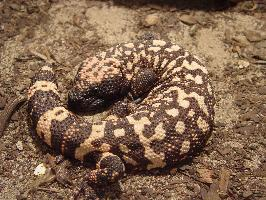
Súlyok és méretek
| Hossz | 0,5 m |
|---|
Állatleírás
The Gila monster (Heloderma suspectum) is a captivating and unique species of venomous lizard that is native to the southwestern United States and northwestern Mexican states. This remarkable reptile belongs to the family Helodermatidae, which comprises only a few species of venomous lizards. The Gila monster holds the distinction of being one of the only two venomous lizards found in North America, alongside its close relative, the Mexican beaded lizard (Heloderma horridum).Physical Characteristics
The Gila monster possesses a stout, robust body that can reach lengths of up to 2 feet (about 60 cm), making it one of the largest lizards native to the United States. Its skin is covered in bead-like scales known as osteoderms, which are actually bony deposits that provide the lizard with a distinctive, rugged texture. The coloration of these creatures is striking and serves as a warning to potential predators; it consists of black markings interspersed with pink, orange, or yellow patterns. This vivid coloration is an example of aposematic coloration, a natural warning signal indicating the animal's venomous nature to would-be predators.
Behavior and Habitat
Gila monsters are primarily ground-dwelling creatures that prefer arid and semi-arid environments, such as deserts, scrublands, and succulent forests. They are adept at burrowing and often take refuge in burrows abandoned by other animals, or beneath rocks and in crevices to escape the extreme heat of their habitat. Gila monsters are known for their sluggish nature, moving slowly and deliberately. They are primarily active during the morning and evening hours to avoid the scorching midday temperatures.
Diet
As carnivorous animals, Gila monsters feed on a variety of prey, including small mammals, birds, eggs, insects, and carrion. They have a powerful bite and utilize their venom to subdue larger or more resistant prey. The venom is delivered through grooves in the lower teeth, which are chewed into the prey to ensure venom transfer. Despite their venomous capability, Gila monsters are not considered a significant threat to humans, as they are slow-moving, reclusive, and typically avoid human contact.
Reproduction
Gila monsters are oviparous, meaning they lay eggs. Mating typically occurs in the spring, and after a gestation period, the female lays a clutch of eggs in a burrow or other protected area. The eggs are left to incubate with no further parental care, and the young Gila monsters are entirely independent upon hatching.
Conservation Status
The Gila monster is classified as Near Threatened by the International Union for Conservation of Nature (IUCN). Its populations are facing pressures from habitat loss due to agricultural expansion, urbanization, and collection for the pet trade. In addition, their slow reproductive rate makes it difficult for populations to recover from declines. Conservation efforts are in place to protect their natural habitats and regulate trade, ensuring the survival of this fascinating species for future generations.
In summary, the Gila monster is a distinctive and intriguing reptile, known for its venomous bite, striking appearance, and unique behaviors. Despite its fearsome reputation, it plays an important role in its ecosystem and continues to fascinate scientists, conservationists, and reptile enthusiasts alike.
Új állatfotók
Top 10 állat
- Diana monkey (Cercopithecus diana)
- Dolphin gull (Leucophaeus scoresbii)
- Galápagos tortoise (Geochelone nigra complex)
- Moustached guenon (Cercopithecus cephus)
- Japanese spider crab (Macrocheira kaempferi)
- Colossal squid (Mesonychoteuthis hamiltoni)
- Stone loach (Barbatula barbatula)
- Common house mosquito (Culex pipiens)
- Common reed warbler (Acrocephalus scirpaceus)
- Sea urchins (Echinoidea)